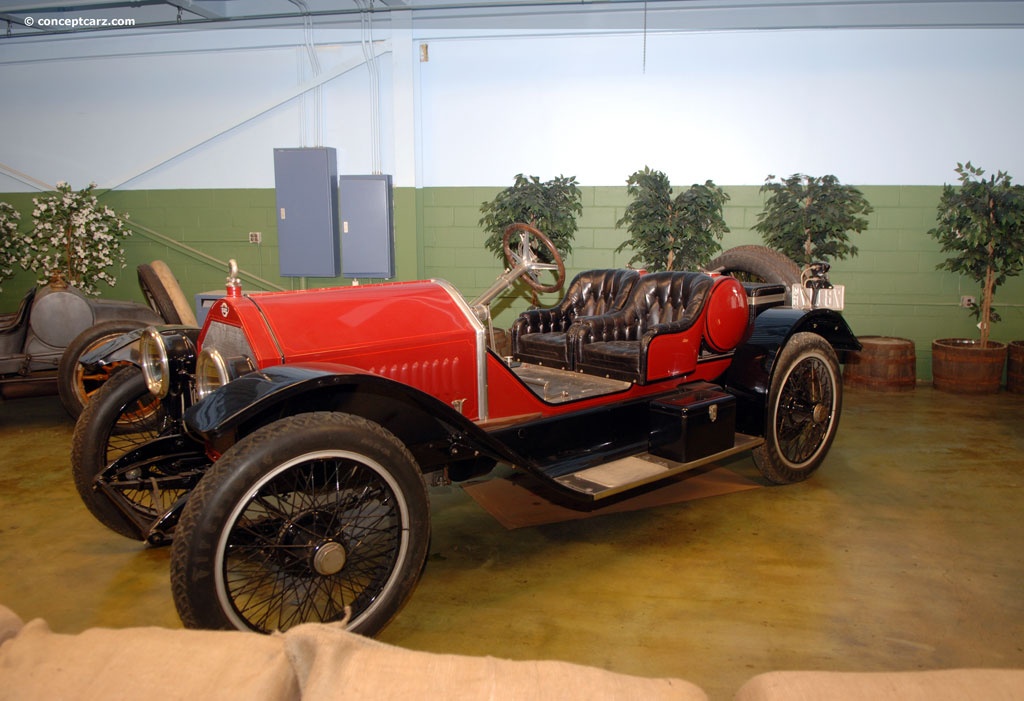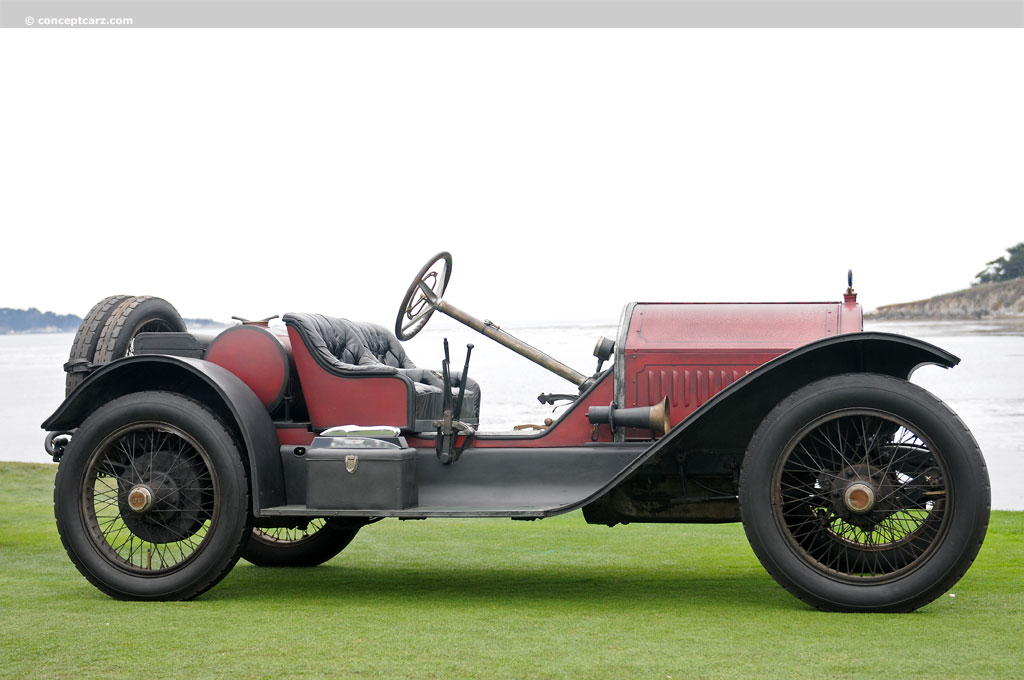Harry Stutz served as chief engineer for the American Motor Car Company before moving in 1910 to the Marion Motor Car Company, both were based in Indianapolis. He then founded the Stutz Auto Parts Company where he and a colleague built and sold axles and gearboxes. The transaxle he designed would become a defining feature of early Stutz automobiles. The first Stutz automobile was ready in early 1911. 
RoadsterSo confident in his product, Harry Stutz chose to race the prototype in the inaugural Indianapolis 500. Throughout the race, it struggled with tire issues, but it managed a respectable 11th place finish with an average speed of 68 mph. Having gone from the drawing board to the race track in just weeks, Harry Stutz proudly advertised his vehicle as 'The Car That Made Good in a Day.' With proper time and development, the Stutz automobiles earned an enviable competition record, securing a 3rd place finish in the 1913 Indianapolis 500. During 1912, Stutz won 25 out of 30 competitions entered, with its first victory won at Bakersfield, followed by two more at San Jose. Earl Cooper placed 4th at Santa Monica and won seven of eight major races in 1931. The company's famous 'White Squadron' of racing cars, driven by Cooper, Gil Anderson and Howdy Wilcox, won in 1915 at Elgin, Point Loma, and Sheepshead Bay. At the Indianapolis 500, they placed 3rd, 4th, and 7th.The cars driven by The White Squadron were specially designed overhead-camshaft, four-valve-per-cylinder racing cars that were painted in dazzling white. Additionally, the drivers and mechanics wore similarly attired white coveralls. The Stutz Bearcat
Racing accomplishments and Stutz's engineering prowess made the company's products popular with wealthy customers. The most iconic and sporty model within its portfolio was the Bear Cat, later known as the Bearcat, beginning in 1913. The 1912 factory catalogue declared, 'We are now building duplicates of this 'car that made good in a day' with absolutely the same material, workmanship, and design,'
Roadster
Chassis #: 3021
View info and history
Auction entries : 1Introduced in 1912, the Bear Cat was essentially a race car for the road, with a low-slung chassis, drivetrain, barely-there fenders, a steering column, and a pair of seats. Stutz sales literature of the period boasted the Bearcat was 'designed to meet the requirements of the customer desiring a car built along the general lines of a racing car and with a slightly higher gear ratio than our regular torpedo roadster.'The Bearcat could initially be equipped with either four- or six-cylinder engines. The 389 cubic-inch four-cylinder T-head unit produced by the Wisconsin Motor Manufacturing Company of Milwaukee had a twin camshaft 'T-Head' configuration with inlet valves on one side of the block and exhausts on the other. This engine was used up to 1917 when Stutz began to produce its own powerplants. The engines were paired with Stutz's own rear three-speed transaxle. The solid front axle and live rear axle were suspended by semi-elliptic leaf springs. Two-wheel mechanical drum brakes provided the stopping power. With a cost of $2,000 in 1913, the Bearcat included a Warner speedometer, Bosch ignition, three-speed transaxle, and a tool kit. Color options included Yellow, Mercedes Red, Vermilion, or Monitor Grey. The four-cylinder Bearcat had a 120-inch wheelbase, while the size-cylinder version rested atop a larger, 124-inch platform. Cannon Ball Baker
In 1915, Cannon Ball Baker took a stock Bearcat from the showroom to a record-breaking cross-country run. With roads virtually nonexistent, he drove from San Diego to New York in 11 days, 7 hours and 15 minutes, suffering just one broken shock absorber clip during this expedition. It was the first of 143 distance records 'Cannonball' would establish. This accomplishment, plus numerous other feats, earned it the nickname 'The Sturdy Stutz.'Walter Brown
Most automakers of the Brass Era were regional, meaning distribution remained fairly local. Equally brilliant in sales as he was in engineering, Stutz wanted to expand regional boundaries. To achieve this, Stutz worked with many capable individuals, including a Santa Monica-based dealer named Walter Brown, who established a Los Angeles-based team of Stutzes in September 1911. Period advertisements from The Los Angeles Times indicate that Stutzes first raced in California around this time. The 1916 Stutz Bearcar
The 1916 Stutz models included the Series C and the Bulldog Special, both equipped with four-cylinder engines delivering approximately 50 horsepower. The Series C rested on a 120-inch wheelbase, and the Bulldog Special model atop a 130-inch wheelbase platform. Body styles offered on the Series C included a two-passenger roadster priced at around $2,100, the Bulldog at $2,250, the Sedan at $3,695, and the Bearcat at $2,000. The larger Bulldog Special listed at $2,250 for the four-passenger tourer and $2,300 for the five-passenger tourer.
Roadster
View info and historyFor 1917, Stutz would consolidate down to a single model line - the Series R - with all but the Bearcat resting on the 130-inch wheelbase; the Bearcat used the shorter 120-inch platform. Production of Stutz automobiles continued through 1935. Production of the Bearcat (as a model) ended in 1925. The name returned in 1931 as a coupe body style on the DV-32 with dual side-mounted spare tires and a dip in the doors. The name continued for two years, ending in 1933, its final farewell being the 'Super Bearcat.'
by Daniel Vaughan | May 2023

Roadster
Racing accomplishments and Stutz's engineering prowess made the company's products popular with wealthy customers. The most iconic and sporty model within its portfolio was the Bear Cat, later known as the Bearcat, beginning in 1913. The 1912 factory catalogue declared, 'We are now building duplicates of this 'car that made good in a day' with absolutely the same material, workmanship, and design,'

Roadster
Chassis #: 3021
View info and history
Auction entries : 1
In 1915, Cannon Ball Baker took a stock Bearcat from the showroom to a record-breaking cross-country run. With roads virtually nonexistent, he drove from San Diego to New York in 11 days, 7 hours and 15 minutes, suffering just one broken shock absorber clip during this expedition. It was the first of 143 distance records 'Cannonball' would establish. This accomplishment, plus numerous other feats, earned it the nickname 'The Sturdy Stutz.'Walter Brown
Most automakers of the Brass Era were regional, meaning distribution remained fairly local. Equally brilliant in sales as he was in engineering, Stutz wanted to expand regional boundaries. To achieve this, Stutz worked with many capable individuals, including a Santa Monica-based dealer named Walter Brown, who established a Los Angeles-based team of Stutzes in September 1911. Period advertisements from The Los Angeles Times indicate that Stutzes first raced in California around this time. The 1916 Stutz Bearcar
The 1916 Stutz models included the Series C and the Bulldog Special, both equipped with four-cylinder engines delivering approximately 50 horsepower. The Series C rested on a 120-inch wheelbase, and the Bulldog Special model atop a 130-inch wheelbase platform. Body styles offered on the Series C included a two-passenger roadster priced at around $2,100, the Bulldog at $2,250, the Sedan at $3,695, and the Bearcat at $2,000. The larger Bulldog Special listed at $2,250 for the four-passenger tourer and $2,300 for the five-passenger tourer.

Roadster
View info and history
by Daniel Vaughan | May 2023
Related Reading : Stutz Bearcat History
The Stutz Bearcat was produced from 1914 through 1924. The first version was produced from 1914 to 1917 and was powered by a 6388 cc four-cylinder engine. The Bearcat was a creation inspired by an Indy sports car racer built by the Stutz Motor Company in 1911. It was powered by a 361 cubic-inch four-cylinder engine that produced 50 horsepower. The Bearcat continued the tradition of lightweight construction,....
Continue Reading >>
Continue Reading >>
Similar Vehicles
Similar Automakers
Similarly Sized Vehicles
from 1916
1916 Stutz Bearcat Vehicle Profiles
Recent Vehicle Additions
Performance and Specification Comparison
Bearcat Specification Comparison by Year
Year
Production
Wheelbase
Engine
Prices
Related Automotive News

Gooding & Company Presents the Best of American Motoring, from Brass Era Legends to Postwar Sports Cars, at Its Pebble Beach Auctions
An incredible 1912 Simplex 50 HP Toy Tonneau, offered for sale from 111 years of single family ownership, will come to market for the first time, alongside motoring icons from the greatest eras of American automotive history.
The official auction...

Gooding & Company Looks Toward Pebble Beach with Stunning Selection of Historic Prewar Classics
Highlights include a top-of-the-line 1930 Duesenberg Model J Disappearing-Top Convertible Coupe, a Grand Prix-winning 1929 Bugatti Type 35B, a well-documented 1914 Stutz 4E Bearcat, and an opulent 1910 Rolls-Royce 4050 HP Silver Ghost Pullman Limousine.
As...

An Elegant Lineup of Prewar Classics are Unveiled for Gooding & Company's 2020 Scottsdale Auctions
Highlights include a BMW 328 from single family ownership with storied history, the striking Hispano-Suiza J12, a beautifully restored Stutz Series M, and a Cord 812 SC Cabriolet with exceptional provenance
Santa Monica, Calif. (December...

Alfa Romeo Named Best of Show at the 68th Pebble Beach Concours d'Elegance
Touring-Bodied Alfa Romeo 8C 2900B Named Best of Show at the 68th Pebble Beach Concours dElegance
PEBBLE BEACH, Calif. (August 26, 2018) — After an intense competition that drew diverse cars from around the globe, the coveted gold Best of Show...

WORLD RECORDS TUMBLE AT BONHAMS' INAUGURAL $14-MILLION AMELIA ISLAND AUCTION
Pre-war American cars sell strongly while models from Alfa Romeo, BMW and Porsche make world auction records
Amelia Island, Florida – The much-anticipated addition to the Amelia Island Car Week – whose cornerstone is the renowned Amelia...





























